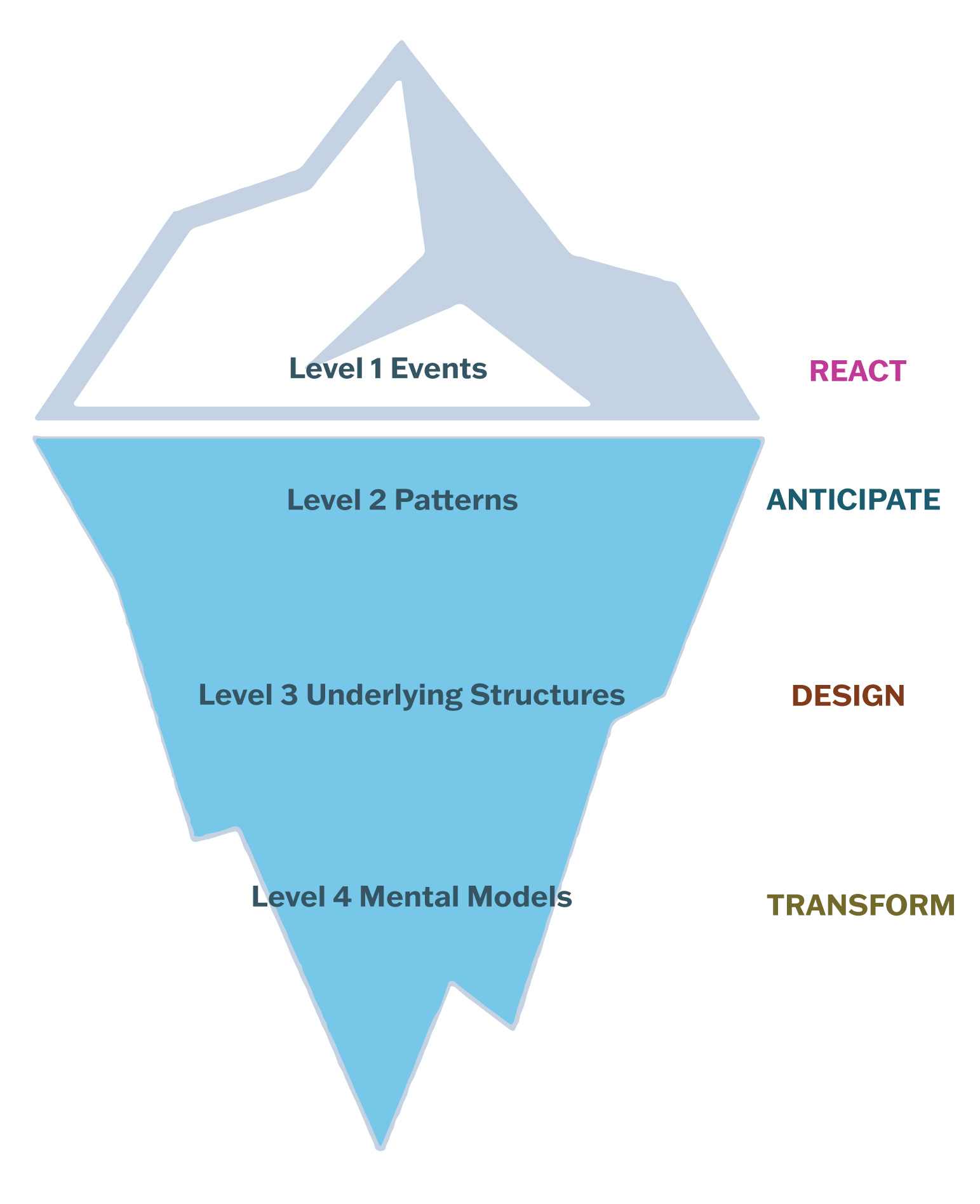Applying the Iceberg Model
If you want to deeply understand a problem and if you want to create sustainable, equitable transformation of the system that is holding the problem in place, then you should apply the iceberg model.
The Iceberg Model can be incorporated into a wide range of fields of study, from environmental science to social justice to business management. For example, in an environmental science course, learners could use the iceberg model to analyze the root causes of climate change and develop strategies for reducing greenhouse gas emissions. In a social justice course, they could use it to understand the systemic factors that contribute to racism and discrimination, and develop solutions for promoting equity and inclusion.
The following are instructions which can be adapted and used in a classroom setting.
Step 1: Ask learners to choose a problem to think about.
You may wish for your learners to work with a specific course-related example, or you may want to provide them with an article about a particular issue that they can then work with. Or just have learners choose a complex problem they care about. Whatever the issue, be ready to dive in and think deeply about it.
Step 2: Work through each layer of the problem.
Consider downloading this worksheet from Map the System Canada and using it to work through the layers of the problem your learners have chosen. Or, follow the instructions given here.
The Iceberg Model identifies four basic levels: Level 1 - Event; Level 2 - Patterns and trends; Level 3 - Structures of the System; Level 4 - Mental Models. Each of these levels will be explained in turn below. Click on each level to learn more.

Humber College
This level represents the visible aspects of the problem. Have learners describe this level with a clear outline of the problem that they are working with.
Guiding Questions:
- What catches our attention about this problem?
- What is happening right now?
- What can we see?
This level describes trends over time. It asks learners to investigate if there are patterns to this problem that they are observing. Patterns help learners understand the trends and the dynamics of the problem over time.
Guiding Questions:
- What patterns can I find that relate to the events I observe above?
- What has been happening over time?
- What are the trends?
This level describes how the parts are interrelated or interconnected to influence the patterns. Structures can be understood as the “rules of the game.” They can be written or unwritten; they can be physical and visible or invisible. They may be laws, policies (i.e., laws regulating water use or domestic violence), or informal relationships (illegal activity, social norms and cultural practices). At this level, learners should be trying to discern the structure of the system behind the problem.
Guiding Questions:
- What sort of structures might explain these patterns?
- What has influenced and connected the patterns? For example, social rules, policies, guidelines, or distribution of resources.
This is the level of our deeply held (often unconscious) belief systems or values that reinforce everything else in the system. The mental models are the ways of thinking and seeing the world that helped to shape the structures in the first place. Ask learners to identify any relevant mental models. Mental models are difficult to identify because they stem from assumptions rooted in our society and surroundings and are often examples of implicit knowledge. We may not always be aware of them, so this level requires careful thought.
Guiding Questions:
- What are the mental models that we often learn subconsciously from our society or family and are unaware of?
- What attitudes, beliefs, morals, expectations, or values do people hold about the system?
- What are the, often unspoken, ways of seeing or knowing that shape our attitudes towards the issue of focus?
Step 3: Reflect and synthesize.
After the layers of the iceberg are filled out, consider the ways the various levels interact and connect with each other. Ask:
- What interactions can we see between various layers of this issue/problem?
- How do the mental models reinforce the structures and vice versa?
- How do the events connect with and contribute to the patterns, etc.?
When we consider the interconnections, we are thinking deeply about the issue/problem as a whole instead of just focusing on its most obvious parts. In other words, we are using systems thinking.
Key Takeaways
You should now see how the Iceberg Model can be used to help learners better understand complex problems and develop more sustainable solutions. By breaking down a problem into its different layers, the model allows learners to see beyond the surface-level symptoms of the problem and uncover its deeper underlying structures and mental models.
To use the iceberg model in virtually any classroom setting, instructors can provide learners with a specific problem to analyze or allow them to choose their own. They can then guide them through each level of the model using the guiding questions provided, encouraging them to think critically and deeply about the problem and its underlying structures.